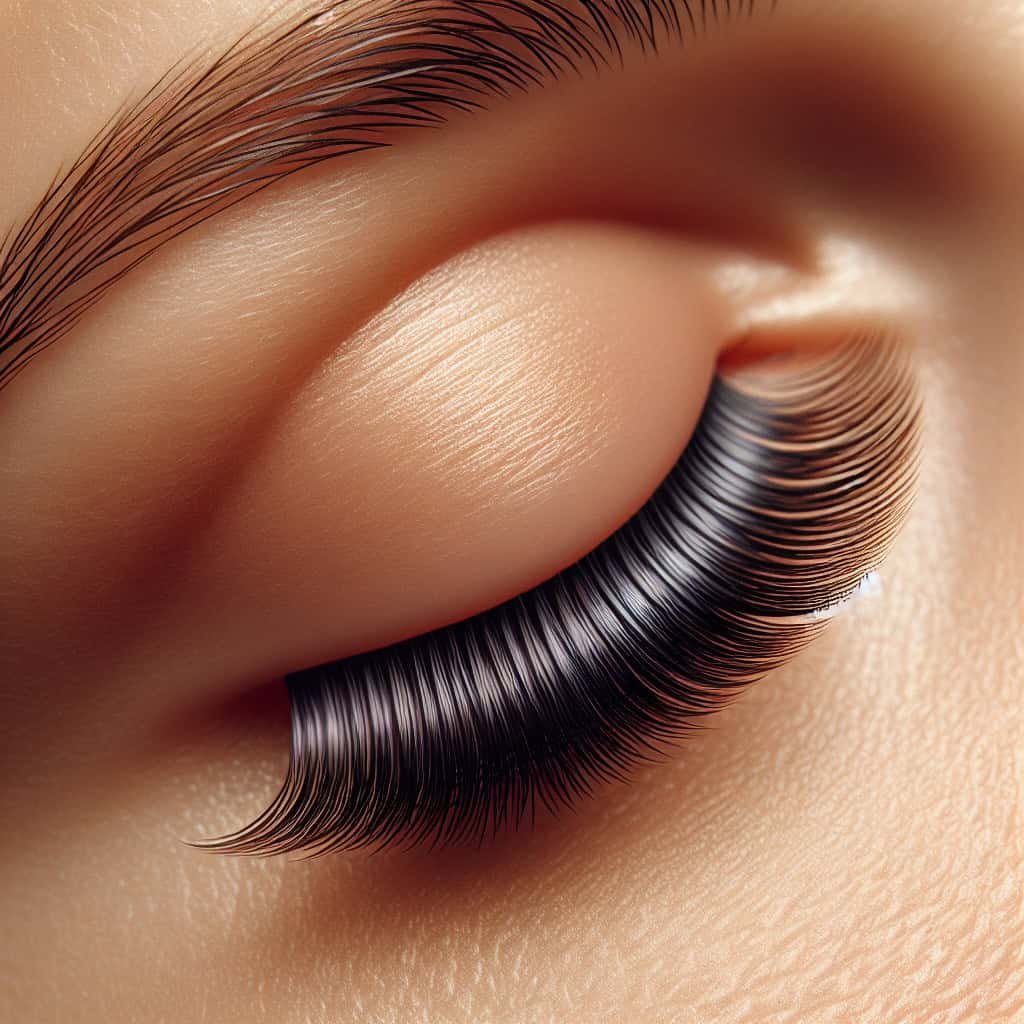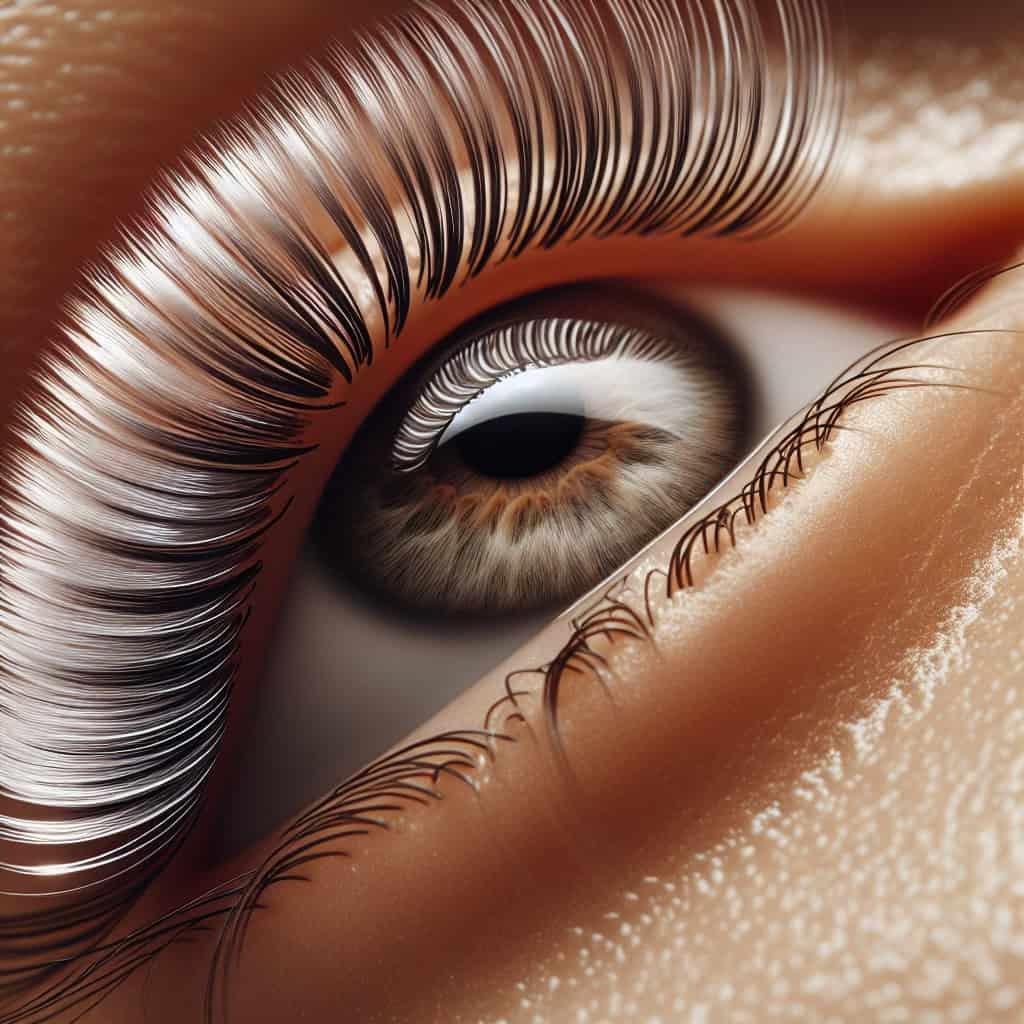If you’ve ever wondered how experts handle the issue of lash adhesive residue on natural lashes, worry no more! In this article, we’ll explore the tried-and-tested methods that professionals use to address this common concern. Whether you’re a lash enthusiast or a newbie, you’ll discover practical tips and solutions that will help you maintain healthy and pristine lashes, while still enjoying the beautiful benefits of lash extensions. So, let’s dive in and uncover the secrets to banishing lash adhesive residue once and for all!

1. Understanding Lash Adhesive Residue
Lash adhesive residue refers to the leftover glue that remains on natural lashes after the removal of lash extensions. It is a common concern amongst individuals who regularly wear lash extensions. Understanding lash adhesive residue is crucial in maintaining the health and integrity of natural lashes.
1.1 What is lash adhesive residue?
Lash adhesive residue is the sticky substance that remains on natural lashes even after the removal of lash extensions. It is primarily composed of the adhesive used to attach the extensions to the natural lashes. The residue can vary in consistency, ranging from a thin film to a more substantial buildup, depending on the amount and type of adhesive used.
1.2 How does it affect natural lashes?
Lash adhesive residue can have several negative effects on natural lashes. Firstly, the residue can make the lashes appear clumped together, causing them to look unnatural and uneven. It can also weigh down the lashes, making them appear less voluminous and less curled.
In addition to the aesthetic concerns, lash adhesive residue can also affect the health of natural lashes. The residue can clog the hair follicles, leading to poor lash growth and potential lash loss. It can also cause irritation and inflammation of the lash line, which can be uncomfortable and even painful.
1.3 Common concerns associated with lash adhesive residue
There are several common concerns associated with lash adhesive residue. One of the primary concerns is the difficulty in completely removing the residue. Some individuals may find that even after thorough cleansing, a trace amount of residue remains, causing frustration and concern.
Another concern is the potential for lash damage caused by improper removal techniques. If the residue is not removed gently and carefully, it can result in the pulling or tearing of natural lashes, leading to further damage and potential breakage.
Lastly, individuals may worry about the long-term effects of lash adhesive residue on the health and integrity of their natural lashes. They may question whether repeated use of lash extensions and the associated residue can cause permanent damage or hinder the natural growth cycle of their lashes.
2. Preventive Measures for Lash Adhesive Residue
Taking preventive measures can significantly reduce the likelihood and severity of lash adhesive residue. By implementing the following techniques and precautions, individuals can maintain the health and appearance of their natural lashes.
2.1 Choosing the right lash adhesive
Selecting a high-quality lash adhesive is essential in minimizing adhesive residue. It is recommended to opt for adhesives that are specifically formulated for sensitive eyes and have a low fume and low irritation potential. Checking the ingredients and researching the reputation of the adhesive brand can help ensure a suitable choice.
2.2 Proper application technique
Proper application technique plays a crucial role in minimizing adhesive residue. Lash extensions should be applied carefully and precisely, ensuring that the adhesive is applied only to the extension and does not come into direct contact with the natural lashes. This technique helps prevent excess adhesive from seeping onto the natural lashes and reducing the chance of residue buildup.
2.3 Limiting the amount of adhesive used
Using the appropriate amount of adhesive is essential in preventing excessive residue. It is important to strike a balance between using enough adhesive for secure attachment and avoiding using an excessive amount that can lead to residue buildup. A skilled lash technician can accurately gauge the required amount of adhesive to minimize residue.
2.4 Avoiding contact with natural lashes
To prevent lash adhesive residue, it is crucial to avoid direct contact between the adhesive and the natural lashes. The lash technician should be mindful of the placement of the extensions and ensure that no adhesive comes into contact with the natural lashes. This precaution minimizes the chances of residue formation and maintains the health of the natural lashes.
2.5 Using a lash primer
Applying a lash primer prior to lash extension application can help create a barrier between the natural lashes and the adhesive. A lash primer acts as a protective layer, preventing the adhesive from directly adhering to the natural lashes. This additional step can significantly reduce the accumulation of adhesive residue.
2.6 Ensuring cleanliness and hygiene
Maintaining cleanliness and hygiene during the lash extension application process is vital in preventing lash adhesive residue. Both the lash technician and the client should ensure that their hands are washed and sanitized thoroughly before the application. Additionally, all tools and equipment should be cleaned and disinfected properly to minimize the risk of residue-causing contamination.
2.7 Patch testing adhesive products
To mitigate the risk of adverse reactions and residue formation, it is recommended to perform a patch test before using any lash adhesive product. This involves applying a small amount of the adhesive on the inner forearm or behind the ear and monitoring for any signs of irritation or allergic reactions. Patch testing helps identify potential problems beforehand and allows for adjustments or alternative options to be explored.
By following these preventive measures, individuals can minimize the occurrence of lash adhesive residue and maintain the integrity and health of their natural lashes.
3. Effective Removal of Lash Adhesive Residue
Removing lash adhesive residue safely and effectively is crucial in maintaining the health of natural lashes. Improper removal techniques can lead to damage, breakage, and further residue buildup. By following the steps outlined below, individuals can ensure a gentle and successful removal process.
3.1 Using a gentle lash adhesive remover
Using a gentle and specially formulated lash adhesive remover is essential in safely removing residue without causing damage to the natural lashes. It is important to choose a remover that is specifically designed for lash extension removal and is free from harsh chemicals or irritants.
3.2 Steps for safe adhesive removal
To safely remove lash adhesive residue, follow these steps:
- Firstly, cleanse the eye area with a mild and oil-free cleanser to remove any makeup or debris.
- Apply a small amount of the lash adhesive remover onto a microfiber brush or a lint-free cotton pad.
- Gently brush or wipe the lashes with the remover, focusing on areas with visible residue.
- Allow the remover to sit for a few minutes to soften the adhesive.
- Using a clean and soft spoolie brush, gently comb through the lashes to remove any softened residue.
- Continue the process until all visible residue has been removed.
- Rinse the eye area with water to ensure the removal of any remaining residue or remover.
- Pat the lashes dry with a clean towel or tissue.
3.3 Caring for natural lashes post-removal
After removing lash adhesive residue, it is important to provide proper care to the natural lashes to encourage their health and regrowth. Avoid applying any makeup or lash products immediately after removal to allow the lashes to breathe and recover. Additionally, refrain from rubbing or tugging at the lashes to prevent further damage.
3.4 Seeking professional assistance if needed
If individuals are unsure about or uncomfortable with removing lash adhesive residue themselves, it is advisable to seek professional assistance. Lash technicians or estheticians who specialize in lash extensions can provide expert removal services, ensuring gentle treatment and minimal residue.
3.5 Avoiding excessive rubbing or pulling
During the removal process, it is crucial to avoid excessive rubbing or pulling of the natural lashes. Vigorous rubbing or tugging can lead to lash breakage, thinning, and damage to the hair follicles. By being gentle and patient during the removal process, individuals can protect their natural lashes from unnecessary harm.
By effectively removing lash adhesive residue and providing proper aftercare, individuals can maintain the health and integrity of their natural lashes while enjoying the benefits of lash extensions.
4. Addressing Allergic Reactions and Irritation
Allergic reactions and irritation can occur as a result of lash adhesive residue or the lash extension application process. Expert lash technicians are well-equipped to address these concerns and provide appropriate solutions.
4.1 Signs of allergic reactions
Allergic reactions typically manifest as redness, itching, swelling, or a rash in the eye area. These symptoms may appear immediately after the lash extension application or may develop gradually over time. It is important to recognize and address these signs promptly to prevent further discomfort and potential complications.
4.2 Immediate actions for irritation
If an individual experiences irritation or discomfort during or after the lash extension application, it is recommended to take the following immediate actions:
- Inform the lash technician about the symptoms and concerns.
- Rinse the eye area with cool water to soothe any discomfort.
- Apply a cold compress or a cool, damp cloth to reduce swelling and inflammation.
- Refrain from rubbing or touching the eyes to avoid exacerbating the irritation.
4.3 Consulting with a professional
If the symptoms persist or worsen, it is advisable to consult with a professional lash technician, esthetician, or an ophthalmologist. They can conduct a thorough assessment of the situation, identify the cause of the irritation, and provide appropriate recommendations or treatment.
4.4 Adjusting adhesive products or application techniques
If an individual consistently experiences allergic reactions or irritation, an expert lash technician can help address the issue by adjusting the adhesive products or application techniques. They may switch to hypoallergenic or sensitive adhesive formulas or modify the lash extension application process to minimize the risk of adverse reactions.
4.5 Exploring alternative options for sensitive individuals
For individuals with severe allergies or sensitivities, lash extensions may not be a suitable option. However, there are alternative options available that can provide similar results without the risk of adverse reactions. Lash lifts, for example, can enhance the natural lashes without the use of adhesive, making them a viable alternative for those with sensitive eyes.
Expert lash technicians prioritize the safety and comfort of their clients and are trained to handle allergic reactions and irritation effectively. By seeking professional guidance and exploring alternative options, individuals can find a solution that suits their specific needs and concerns.

5. Maintaining Healthy Natural Lashes
Maintaining healthy natural lashes is crucial for individuals who regularly wear lash extensions. By following a proper lash care routine and adopting a mindful approach towards lash products and removal techniques, individuals can promote the health and longevity of their natural lashes.
5.1 Practicing proper lash care routine
Incorporating a regular lash care routine is essential in maintaining the health of natural lashes. This routine may include gentle cleansing of the lashes, avoiding the use of oil-based or waterproof makeup removers, and using a lash-friendly mascara if desired. It is also important to remove any makeup or debris from the eye area before going to bed to prevent potential irritation or damage to the lashes.
5.2 Avoiding excessive use of mascara or other products
While mascara can enhance the appearance of lash extensions, it is important to use it sparingly and choose a mascara that is compatible with lash extensions. Excessive use of mascara or other lash products can lead to product buildup and residue formation, which can compromise the health and appearance of natural lashes.
5.3 Removing makeup effectively
When removing makeup, it is important to be gentle and thorough to avoid leaving behind any residue that can clog the hair follicles and lead to lash issues. Using a gentle, oil-free makeup remover formulated specifically for the eye area and ensuring complete removal of makeup around the lash line can help maintain the health and cleanliness of the natural lashes.
5.4 Regularly conditioning lashes
Conditioning the lashes can help keep them nourished, hydrated, and resilient. Using a lash conditioner or applying natural oils, such as castor oil or argan oil, to the lashes can promote healthy growth, prevent brittleness, and enhance the overall appearance of the lashes. However, it is important to avoid applying excessive amounts or getting the conditioner or oil too close to the lash line to minimize the risk of residue formation.
5.5 Being cautious with extension removal
When it comes time to remove lash extensions, it is crucial to exercise caution and use gentle techniques to avoid damaging the natural lashes. Using proper removal tools and solutions, as well as seeking professional assistance if needed, can help ensure a safe and effective removal process.
5.6 Monitoring lash health and seeking professional advice when needed
Regularly monitoring the health and condition of natural lashes is essential in identifying any potential issues or concerns. If individuals notice any changes in lash growth, appearance, or experience persistent discomfort, it is advisable to seek professional advice. Expert lash technicians or healthcare professionals can assess the situation, provide guidance, and recommend appropriate treatments or adjustments.
By incorporating these practices into their routine, individuals can promote the health and longevity of their natural lashes and achieve the best possible results when wearing lash extensions.
6. Educating Clients about Lash Adhesive Residue
Educating clients about lash adhesive residue and providing them with the necessary information and guidance is a critical aspect of the lash extension process. By proactively communicating about potential risks, aftercare instructions, and addressing client concerns, lash technicians can create a collaborative and mutually beneficial relationship with their clients.
6.1 Importance of client education
Client education is crucial in ensuring that individuals understand the potential risks and benefits associated with lash extensions. By providing detailed information about lash adhesive residue, clients can make informed decisions, better care for their natural lashes, and actively participate in their lash health journey.
6.2 Communicating about potential risks
During the consultation and lash extension application process, lash technicians should openly discuss the potential risks and concerns associated with lash adhesive residue. This includes addressing the possibility of residue formation, the importance of proper aftercare, and seeking professional assistance when needed. Clear and open communication fosters trust and allows clients to make informed decisions regarding their lash extensions.
6.3 Instructions for aftercare and maintenance
Providing clients with comprehensive aftercare instructions is essential in minimizing the risk of excessive residue formation. Lash technicians should educate clients on proper cleansing techniques, avoiding certain products or treatments, and the importance of regular maintenance appointments. Clear and concise instructions empower clients to take an active role in maintaining the health and appearance of their lash extensions.
6.4 Addressing client concerns and questions
Throughout the lash extension process, clients may have questions or concerns about lash adhesive residue, removal techniques, or other related topics. Expert lash technicians should create a safe and welcoming environment where clients feel comfortable expressing their concerns. By actively listening and addressing client questions, technicians can provide reassurance, dispel any misconceptions, and promote trust and understanding.
6.5 Collaborating with clients for optimal lash health
Maintaining open lines of communication and fostering a collaborative relationship with clients is essential for the optimal health of their natural lashes. Lash technicians should encourage clients to share any changes or concerns they may have regarding their lash health or the presence of residue. By actively involving clients in their lash care journey, technicians can tailor their approach to address individual needs and ensure long-term satisfaction.
By prioritizing client education and communication, lash technicians can empower their clients to make informed decisions, actively participate in their lash health, and minimize the risks associated with lash adhesive residue.

7. Tips for Corrective Measures
In situations where lash adhesive residue has already accumulated or caused damage, corrective measures can help restore and rehabilitate the natural lashes. Expert lash technicians can employ various techniques to address these issues effectively.
7.1 Assessing lash damage and determining required actions
Before implementing any corrective measures, it is important to assess the extent of lash damage caused by adhesive residue. An experienced lash technician can evaluate the lashes’ condition, density, and overall health to determine the appropriate actions.
7.2 Removing excessive residue
For excessive residue buildup, specialized removal techniques may be necessary. An expert lash technician can use gentle methods, such as the application of lash adhesive remover or meticulous combing through the lashes, to delicately remove excess residue without causing further damage.
7.3 Restoring and rehabilitating natural lashes
Once the excessive residue has been removed, the focus shifts to restoring and rehabilitating the natural lashes. This may involve recommending appropriate lash serums or growth-enhancing products, providing nourishing lash conditioning treatments, or advising on lifestyle changes that promote lash health. By offering personalized care, lash technicians can help natural lashes recover and regain their strength and vitality.
7.4 Seeking professional assistance for complex situations
In some cases, corrective measures may be complex or require advanced techniques. Lash technicians should be prepared to refer clients to professionals, such as trichologists or dermatologists, who specialize in hair and scalp health. Collaboration with experts in related fields ensures that clients receive the most comprehensive and tailored care for their specific concerns.
By implementing appropriate corrective measures, lash technicians can help individuals overcome the challenges associated with lash adhesive residue and restore the health and beauty of their natural lashes.
8. Professional Recommendations and Best Practices
As lash extension techniques and products continue to evolve, it is important for lash technicians to stay updated with industry standards and recommendations. By adhering to best practices and considering advancements in product technology, lash technicians can optimize their clients’ experience and maximize the benefits of lash extensions.
8.1 Staying up to date with industry standards
The lash industry is constantly evolving, with new techniques, products, and safety standards emerging regularly. Lash technicians should actively seek educational opportunities, attend conferences, and engage in professional communities to stay updated with the latest industry standards and recommendations. Staying informed ensures that technicians provide the best possible care to their clients.
8.2 Considering product advancements
Advancements in lash adhesive technology and lash extension materials can significantly impact the occurrence of adhesive residue and the overall performance of lash extensions. Lash technicians should research and consider new products on the market, such as improved adhesives with enhanced bonding properties or innovative extension materials that reduce residue formation. By selecting high-quality and advanced products, technicians can provide superior results and minimize potential issues.
8.3 Quality assurance and reliable manufacturers
To ensure the safety and efficacy of lash adhesive products, it is crucial to source them from reliable and reputable manufacturers. Lash technicians should prioritize quality assurance and opt for adhesives that have undergone rigorous testing and meet industry standards. This commitment to quality ensures that clients receive products that are safe, reliable, and less likely to leave residue on natural lashes.
8.4 Proper training and certifications
To provide the most effective and professional care to clients, lash technicians should invest in comprehensive training and certifications. Acquiring the necessary knowledge and skills through reputable training programs equips technicians with the expertise required to address lash adhesive residue concerns effectively. Continuous professional development ensures technicians are up to date with the latest techniques and advances in the industry.
8.5 Networking with fellow professionals
Networking and collaborating with fellow lash technicians can be invaluable in sharing experiences, knowledge, and best practices. Online forums, social media groups, or local lash technician communities are excellent platforms for building connections and exchanging information. By learning from one another, technicians can enhance their skills, stay current with industry trends, and better address the concerns of their clients.
8.6 Seeking mentorship or guidance from experts
Established lash technicians or industry experts can provide valuable mentorship and guidance to those seeking to enhance their skills and knowledge. Mentorship programs, apprenticeships, or one-on-one consultations are effective ways to receive personalized advice and support. By learning from experienced professionals, lash technicians can refine their techniques and approaches, elevating their ability to address common concerns such as lash adhesive residue.
By embracing professional recommendations and adhering to best practices, lash technicians can provide outstanding service, minimize the occurrence of lash adhesive residue, and deliver exceptional results to their clients.

9. Importance of Continuous Research and Development
Continuous research and development are crucial in addressing common concerns and advancing the field of lash extensions. By staying informed about advancements in lash adhesive technology, exploring new treatment options, and collaborating with experts from related fields, lash technicians can provide innovative solutions and optimal care to their clients.
9.1 Advancements in lash adhesive technology
Ongoing research and development in lash adhesive technology can lead to the creation of adhesives with improved bonding strength, reduced residue potential, and enhanced safety profiles. By actively seeking information about these advancements, lash technicians can select the most suitable and effective products for their clients’ needs, minimizing adhesive residue concerns.
9.2 Addressing client concerns through research
Research plays a vital role in understanding the root causes and potential solutions for common lash adhesive residue concerns. By conducting or accessing research studies, lash technicians can deepen their knowledge and gain insights into effective removal techniques, alternative treatments, or innovative product formulations. Applying evidence-based findings to their practice enables technicians to better address client concerns and optimize lash health.
9.3 Collaborating with experts in related fields
Collaboration with experts in related fields, such as trichology, dermatology, or ophthalmology, can provide valuable insights and holistic approaches to lash adhesive residue concerns. By exchanging knowledge and ideas with these professionals, lash technicians can gain a broader understanding of the factors that contribute to residue formation and develop comprehensive strategies for prevention, removal, and aftercare.
9.4 Sharing knowledge and experiences within the industry
Lash technicians can contribute to the advancement of the industry by sharing their knowledge and experiences with fellow professionals. Participating in industry conferences, publishing research or case studies, or teaching educational courses are excellent ways to share insights, techniques, and best practices. By fostering a culture of collaboration and knowledge-sharing, lash technicians collectively elevate the standard of care and address common concerns, such as lash adhesive residue, more effectively.
By embracing continuous research and development, lash technicians contribute to the ongoing improvement of lash extension practices. Their commitment to staying informed, sharing knowledge, and exploring new solutions ensures that clients receive the highest quality of care and experience the best possible outcomes.
10. Conclusion
Understanding and addressing common concerns such as lash adhesive residue on natural lashes is essential for lash technicians and their clients. By following preventive measures, effectively removing residue, addressing allergic reactions and irritation, and maintaining healthy natural lashes, individuals can enjoy the benefits of lash extensions without compromising their lash health.
Through proper client education, open communication, and the implementation of corrective measures when necessary, lash technicians can provide comprehensive care and support for their clients. By staying up to date with industry standards, considering advancements in product technology, and prioritizing continuous research and development, technicians can optimize their practices and offer the best possible solutions for lash adhesive residue concerns.
With a commitment to maintaining optimal lash health and taking proactive measures to address concerns, both lash technicians and clients can enjoy the beauty and confidence that lash extensions offer. By working together and staying knowledgeable about the latest techniques and advancements, the lash industry can continue to thrive and provide exceptional results for individuals seeking to enhance their natural lashes.


